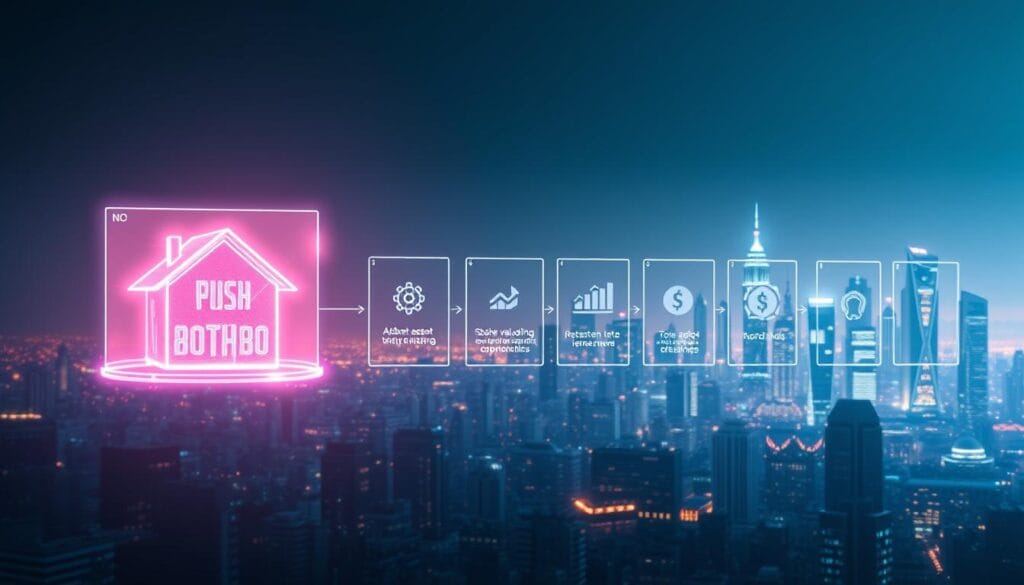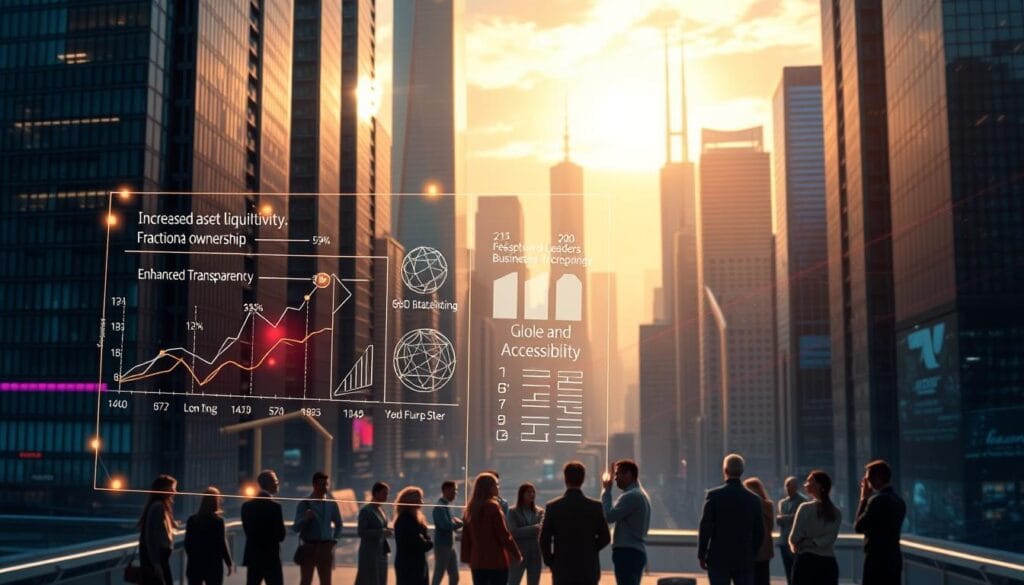McKinsey predicts the tokenized market could hit $2 trillion by 2030. BlackRock CEO Larry Fink believes this shift will redefine finance, stating “every stock, every bond” will eventually adopt this model. Blockchain technology enables fractional ownership, unlocking liquidity for traditionally illiquid holdings like real estate or fine art.
Institutions are accelerating adoption, with major players like BlackRock launching tokenized funds. This bridges traditional finance and Web3, creating a 24/7 global market. Investors gain access to diversified portfolios with lower barriers to entry.
Key Takeaways
- McKinsey forecasts $2 trillion in tokenized market value by 2030.
- Blockchain enables fractional ownership of high-value assets.
- Institutional adoption is growing rapidly across asset classes.
- Tokenization merges traditional finance with decentralized systems.
- Markets could operate globally around the clock.
Understanding the Tokenization of Assets

Financial markets are undergoing a radical transformation through digital ownership models. Unlike traditional systems, these innovations represent holdings as programmable units on a blockchain. This shift enables fractional investments in high-value items, from real estate to rare collectibles.
What Is Asset Tokenization?
Tokenization converts physical or intangible holdings into digital tokens. Each token acts like a digital deed, proving partial or full ownership. For example, a $10M property could be split into 10,000 tokens, each worth $1,000.
Web3 tokenization differs from AI or payment models. While AI tokenizes data for machine learning, Web3 focuses on ownership rights. Stablecoins (fungible) and NFTs (non-fungible) illustrate this spectrum. The former are interchangeable like dollars, while the latter represent unique items like art.
How Blockchain Enables Tokenization
Blockchain’s immutable ledger ensures transparent ownership records. Smart contracts automate processes, such as dividend payments, reducing manual errors. Institutions like Broadridge handle $1 trillion monthly in tokenized transactions.
Hybrid models use private blockchains for compliance. This balances decentralization with regulatory needs. For deeper insights into blockchain’s role, explore effective cryptocurrency trading strategies.
The Tokenization Process: From Physical to Digital

Converting physical holdings into digital units involves a meticulous three-step workflow. Institutions like Securitize and Goldman Sachs deploy specialized infrastructure to ensure legality, security, and market accessibility.
Step 1: Asset Sourcing and Legal Frameworks
Real-world holdings require legal entity creation to validate ownership. Securitize, for example, establishes special-purpose vehicles (SPVs) for real estate digitization. Regulatory classification—whether as securities or commodities—dictates compliance protocols.
Step 2: Digital Issuance and Custody
Goldman Sachs leverages the Canton Network for institutional-grade custody. Cold storage solutions back physical holdings, while smart contracts automate ownership transfers. Investors access tokens via integrated wallets, ensuring seamless digital asset management.
Step 3: Distribution and Secondary Markets
Platforms like Centrifuge and JP Morgan’s Onyx enable trading of tokenized mortgages and bonds. Broadridge’s automated systems handle corporate bond servicing, streamlining transactions. This phase unlocks liquidity through 24/7 global markets.
Key Benefits of Tokenizing Assets

Blockchain technology unlocks new opportunities for investors by breaking down traditional barriers. This shift offers three transformative benefits: broader access, improved liquidity, and unmatched transparency.
Democratizing Investment Access
Fractional ownership lets retail investors participate in high-value markets with minimal capital. For example, tokenized real estate accepts $500 investments versus traditional $50,000+ entries.
Platforms like PAX Gold enable fractional ownership of LBMA-backed gold, bridging precious metals and digital access. Similarly, micro-investing platforms leverage this model for diversified portfolios.
Enhancing Liquidity in Illiquid Markets
Art, real estate, and private equity gain liquidity through 24/7 trading. Smart contracts reduce bond settlement from T+2 to T+0, accelerating transactions.
Carbon credits tracked on immutable ledgers showcase how blockchain unlocks secondary markets for traditionally static assets.
Transparency Through Smart Contracts
Automated royalty distributions for music IP eliminate intermediaries. Immutable records ensure transparency, reducing fraud risks.
Cost savings reach 40–60% by cutting manual processes, per Broadridge’s institutional data. This efficiency underscores the benefits of programmable ownership.
Real-World Use Cases for Tokenized Assets

From luxury properties to climate initiatives, blockchain is unlocking tangible value across industries. These innovations are no longer confined to whitepapers—they’re actively transforming how investors engage with real estate, bonds, and even environmental credits.
Tokenized Real Estate: Breaking Down Barriers
The St. Regis Aspen Resort made headlines with its $18M digital offering, fractionalizing luxury property into accessible shares. Investors worldwide can now own a slice of high-end real estate for as little as $500.
Similar models are expanding to commercial spaces, democratizing an asset class once reserved for the wealthy. Platforms like blockchain technology underpin these transactions, ensuring transparency.
Bonds and Commodities on the Blockchain
OpenEden’s TBILL tokens mirror U.S. Treasury yields, offering global exposure to USD-denominated bonds. This bypasses traditional brokerage hurdles, enabling 24/7 trading.
Agricultural commodities are also digitized—Titanic Distillers tokenized whiskey casks, proving even niche asset classes can gain liquidity.
Carbon Credits and Intellectual Property
Climate DAOs use tokenized carbon credits to track emissions transparently. Meanwhile, Royal.io lets fans invest in music royalties via NFTs, showcasing opportunities beyond traditional finance.
These cases illustrate how digitization bridges physical and digital economies, creating markets where none existed before.
Technologies Powering Asset Tokenization

Modern financial systems rely on advanced technologies to digitize ownership. At the core, blockchain technology ensures trust, while smart contracts automate complex processes. Together, they create a secure infrastructure for managing digital assets at scale.
Blockchain: The Backbone of Trust
Ethereum hosts 68% of tokenized holdings, proving its dominance as a public chain. Enterprises like JPMorgan use private networks such as Canton for compliance. Zero-knowledge proofs bridge this gap, validating transactions without exposing sensitive data.
Cross-chain atomic swaps enable seamless transfers between networks. For example, blockchain-based asset solutions leverage oracles to sync real-world data with on-chain records.
Smart Contracts and Programmability
These self-executing agreements power auto-rolling bond ladders, eliminating manual renewals. Hyperledger Fabric tailors logic for enterprises, while MPC wallets enhance security through multi-party encryption.
Oracles feed external data (e.g., market prices) into contracts, ensuring accuracy. This programmability transforms static holdings into dynamic digital assets, unlocking 24/7 liquidity.
Risks and Challenges in Asset Tokenization

While blockchain-based ownership models offer transformative potential, they also introduce unique risks and challenges. Regulatory gray areas and technological vulnerabilities require careful navigation to ensure sustainable growth in this emerging sector.
Regulatory Uncertainty Across Jurisdictions
Global markets face fragmented oversight, with the EU, U.S., and Asia adopting different approaches. The SEC’s Howey Test creates complexity for tokenized real-world holdings, often requiring case-by-case analysis.
Europe’s MiCA framework provides clearer guidelines but conflicts with U.S. enforcement actions. Asia’s hybrid models add another layer of regulatory uncertainty, particularly for cross-border transactions.
Platforms must implement robust KYC/AML compliance systems to operate in permissionless environments. The FTX collapse underscored the need for segregated custody solutions, now prioritized by institutional players.
Security Concerns and Technological Hurdles
DeFi protocols lost $1.8B to exploits in 2023, highlighting security gaps in smart contract design. Oracle manipulation remains a critical threat, especially for derivatives tied to real-world data feeds.
Third-party audits have become mandatory for institutional adoption. Firms like Chainalysis now offer insurance products covering smart contract failures and private key breaches.
Valuation complexities emerge when digitizing unique physical holdings. Standardized appraisal frameworks are still evolving, creating friction in secondary markets.
Current Examples of Tokenization in Action
Leading financial institutions are now demonstrating the real-world impact of blockchain-based investment models. Today, major players like BlackRock and JPMorgan are deploying these solutions at scale, bridging traditional finance with decentralized systems. These implementations showcase how digitization creates tangible value across asset classes.
BlackRock and the Rise of Tokenized Funds
BlackRock’s BUIDL Fund holds $473M in tokenized U.S. Treasuries on Ethereum. This marks a strategic shift for the world’s largest asset manager, offering investors 24/7 access to government debt yields.
The fund leverages smart contracts for instant settlements, reducing traditional T+2 delays. Analysts predict similar products could dominate fixed-income markets within five years.
Ondo Finance’s Treasury-Backed Tokens
Ondo Finance has gained traction with its OUSG token, mirroring short-term Treasury ETFs. The $387M market cap product demonstrates strong demand for blockchain-native yield instruments.
Unlike traditional bonds, these tokens settle instantly and integrate seamlessly with DeFi platforms. This interoperability unlocks new strategies for institutional portfolios.
JPMorgan’s Onyx Blockchain Platform
JPMorgan’s Onyx processes $2B daily in repo market transactions, proving blockchain’s efficiency for institutional workflows. The platform reduces counterparty risk through atomic settlements.
Recent expansions include tokenized collateral management, enabling real-time asset transfers between banks. Such innovations are redefining interbank liquidity today.
The Future of Tokenized Asset Markets
Global financial systems stand at the brink of a liquidity revolution powered by blockchain. Boston Consulting Group forecasts a $16 trillion tokenized market by 2030, dwarfing earlier estimates. This exponential growth hinges on institutional adoption and scalable infrastructure.
Projected Growth and Market Potential
The $300 trillion global real estate market represents a prime target for digitization. Fractional ownership models could unlock 15–20% annual liquidity growth, per McKinsey data.
Basel III regulations may soon recognize blockchain-based collateral, accelerating bank participation. Quantum computing advancements will likely reshape security protocols by 2027, future-proofing systems against emerging threats.
Integration with Traditional Finance
SWIFT’s blockchain interoperability experiments demonstrate seamless integration between legacy systems and decentralized networks. Central bank digital currencies (CBDCs) could anchor cross-border settlements for tokenized holdings.
AI-driven portfolio tools are emerging, analyzing real-time data across chains. For instance, next-gen robo-advisors may soon automate allocations across digital and traditional finance products.
Institutional-grade DeFi pools are projected to surpass $50B by 2026, merging yield opportunities with regulatory compliance. This convergence marks the next phase of market potential realization.
Conclusion
Digital ownership models are reshaping global finance with unprecedented speed. McKinsey’s $2 trillion projection underscores the market potential, driven by institutional adoption and retail accessibility.
The future hinges on regulatory maturation and cybersecurity evolution. Smart contracts already deliver 40–60% efficiency gains, proving the benefits of programmable finance.
As investment barriers dissolve, transparency and interoperability will define success. This shift isn’t speculative—it’s the inevitable next chapter for global capital markets.

